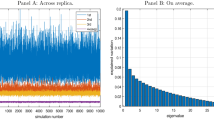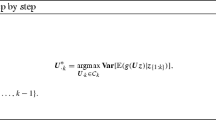Summary
In recent years, constructions based on Brownian bridge [11], principal component analysis [1], and linear transformation [7] have been proposed in the context of derivative pricing to further enhance QMC through dimension reduction. Motivated by [16, 18] and the ANOVA decomposition, this paper (i) formally justifies the dimension minimizing algorithm of Tan and Imai [7], and (ii) proposes a new formulation of linear transformation which explicitly reduces the effective dimension (in the truncation sense) of a function. Another new application of LT method to an interest rate model is considered. We establish the situation for which linear transformation method outperforms PCA.This method is not only effective on dimension reduction, it is also robust and can easily be extended to general diffusion processes.
Access this chapter
Tax calculation will be finalised at checkout
Purchases are for personal use only
Preview
Unable to display preview. Download preview PDF.
Similar content being viewed by others
References
P. Acworth, M. Broadie, and P. Glasserman. A comparison of some Monte Carlo and quasi-Monte Carlo techniques for option pricing. In H. Niederreiter et al., editors, Monte Carlo and Quasi-Monte Carlo Methods 1996: Proceedings of a Conference at the University of Salzburg, Austria, July 9-12, 1996, volume 127 of Lecture Notes in Statistics, pp. 1-18. Springer-Verlag, New York, 1998.
P. Bratley, B.L. Fox, and H. Niederreiter. Implementation and tests of lowdiscrepancy sequences. ACM Transactions on Modeling and Computer Simulation, 2(3):195–213, 1992.
R.E. Caflisch, W. Morokoff, and A. Owen. Valuation of mortgage-backed securities using Brownian bridges to reduce effective dimension. Journal of Computational Finance, l(l):27–46, 1997.
D. Duffie. Dynamic Asset Pricing Theory. Princeton University Press, 2nd edition, 1996.
B. Efron and C. Stein. The jackknife estimate of variance. Annals of Statistics, 9:586–596, 1981.
F.J. Hickernell. A generalized discrepancy and quadrature error bound. Mathematics of Computation, 67(221):299–322, 1998.
J. Imai and K.S. Tan. A general dimension reduction technique for derivative pricing, 2002, submitted for publication.
P.E. Kloeden and E. Platen. Numerical Solution of Stochastic Differential Equations. Springer-Verlag, Berlin Heidelberg, 1992.
W.J. Morokoff. Generating quasi-random paths for stochastic processes. SIAM Review, 40(4):765–788, 1998.
W.J. Morokoff and R.E. Caflisch. Quasi-random sequences and their discrepancies. SIAM Journal Scientific Computing, 15:1251–1279, 1994.
B. Moskowitz and R.E. Caflisch. Smoothness and dimension reduction in quasiMonte Carlo methods. Mathematical and Computer Modelling, 23(8-9):37–54, 1996.
A.B. Owen. The dimension distribution and quadrature test functions. Statistica Sínica, 13:1–17, 2003.
A. Papageorgiou. Fast convergence of quasi-Monte Carlo for a class of isotropic integrals. Mathematics of Computation, 70:297–306, 2001.
I.H. Sloan and H. Woźniakowski. When are quasi-Monte Carlo algorithms efficient for high dimensional integrals. Journal of Complexity, 14:1–33, 1998.
I.H. Sloan and H. Woźniakowski. Tractability of multivariate integration for weighted Korobov classes. Journal of Complexity, 17:691–721, 2001.
I.M. Sobol’. Global sensitivity indices for nonlinear mathematical models and their Monte Carlo estimates. Mathematics and Computers in Simulation, 55:271–280, 2001.
O.A. Vasicek. An equilibrium characterization of the term structure. Journal of Financial Economics, 5:177–188, 1977.
X. Wang and K.-T. Fang. The effective dimension and quasi-Monte Carlo integration. Journal of Complexity, 19:101–124, 2003.
Author information
Authors and Affiliations
Editor information
Editors and Affiliations
Rights and permissions
Copyright information
© 2004 Springer-Verlag Berlin Heidelberg
About this paper
Cite this paper
Imai, J., Tan, K.S. (2004). Minimizing Effective Dimension Using Linear Transformation. In: Niederreiter, H. (eds) Monte Carlo and Quasi-Monte Carlo Methods 2002. Springer, Berlin, Heidelberg. https://doi.org/10.1007/978-3-642-18743-8_16
Download citation
DOI: https://doi.org/10.1007/978-3-642-18743-8_16
Publisher Name: Springer, Berlin, Heidelberg
Print ISBN: 978-3-540-20466-4
Online ISBN: 978-3-642-18743-8
eBook Packages: Springer Book Archive




